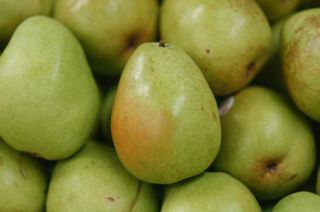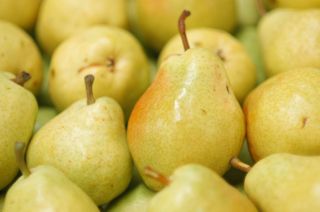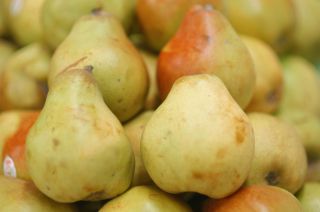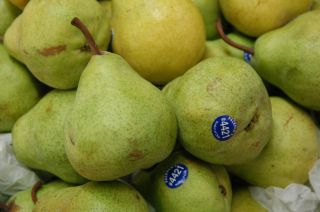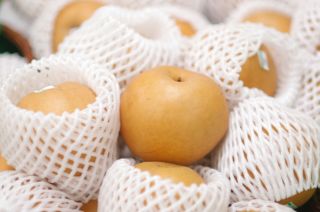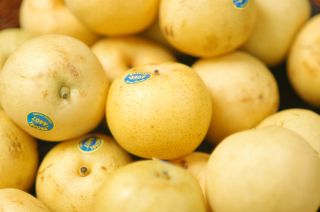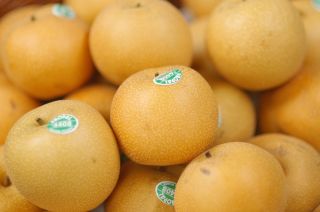Pears are pomes (fruits with distinct cores of seeds from the Rose family) which have been cultivated for thousands of years. Although they are cousins of the apple, pears are much more delicate. Once ripe, pears should be consumed within days even with the aid of refrigeration.
Pear varieties can be classified many ways (creamy/sandy, raw/cooking), but I choose to classify them into two distinct categories: European or buttery varieties and Asian varieties. European pears have been bred to be more aromatic with a smooth and buttery texture. Asian pears are crisp and have a milder flavor.
European pears
The two major types of European pears are the Anjou (sometimes called D'Anjou) and the Bartlett (or Williams). The Anjou variety is a hardy winter variety available from autumn through spring. The Bartlett variety is sweeter, but usually only available from late summer through autumn. The Bartlett withstands cooking well and is the variety most often used in canning and is also available as a dried fruit.
Other notable European pear varieties are the Bosc and the Comice. Bosc pears are firm but not crunchy, and its sturdy structure lends itself to cooking methods such as baking and poaching (as well as eating fresh). The Comice is often regarded as the sweetest and strongest "pear" flavored variety.
European pears are never ripened on the tree because they produce a mealy, gritty texture when allowed to do so. They are picked while they are still firm which also helps the delicate fruit to survive transportation. Store pears in the refrigerator to slow down the ripening process. A few days before you wish to eat the pears, take them out and allow them to ripen at room temperature. Placing pears in paper bags and rotating them each day can help speed ripening due to the trapped ethylene gas. Do not place pears in plastic bags because carbon dioxide could build up resulting in deterioration of the core of the fruit. When pears are ripe, the flesh at the stem gives a little when you lightly press down on it. Waiting until the middle is soft usually results in an overripe pear (because pears ripen from the core outward). After a pear is ripe, you may store it in the refrigerator for only a few days before the fruit dies and begins to deteriorate.
Asian pears
Asian pears are crisp and juicy but with less sweetness than their European counterparts. Unlike European pears, Asian pears are ripened on the tree and can be eaten immediately after picking. In most cases, Asian pears keep in the refrigerator for up to three months (and in the case of the 20th Century variety, up to six months), but if kept too long, they develop a strong wine-like flavor. The skin of Asian pears is quite delicate and sometimes they are packaged in individual foam containers to protect them. (Asian pears have a relatively limited supply and are usually more expensive, so the packagers take extra care to provide perfect looking pears to the market.)
When selecting Asian pears at the market, pick unblemished specimens that are uniform in shape. The pears should be firm and free of any soft spots.
Some properties of pears
The flesh of all pears oxidizes quickly after cutting. To prevent rapid browning, the pear should be cooked or rubbed with an acid (such as lemon, lime, or orange juice) or alcohol. For eating fresh, it is recommended to cut the pears immediately before serving.
Pears have a high water content and are useful for quenching thirst. In addition, they are rich in fiber (a fresh pear is about 3% dietary fiber by weight) and is a decent source of potassium.
Consuming unripe pears are said to have a laxative effect while ripe pears are reputed to be a diuretic and a sedative. Because pears contain a small amount of sorbitol (a sugar alcohol the body cannot process but bacteria in the digestive system can break down for energy), eating too many pears may result in some intestinal discomfort and flatulence.
European pears
Asian pears
Kitchen Notes
Pears
21 comments on Pears:(Post a comment)
On January 31, 2006 at 01:42 AM, Biscuit Girl (guest) said...
How cool! I love how you show the different variety of pears. Next time I go to the market I'll be a little more pear-wise.
On January 31, 2006 at 01:42 AM, krylonultraflat (guest) said...
asian pears are amazingly good in salads.
On January 31, 2006 at 01:42 AM, Alice (guest) said...
Wow, your site is SOOOO interesting! You are my new favorite lunch time companion!!!!
On January 31, 2006 at 01:43 AM, Kristi (guest) said...
I had my first asian pear last year from our fruit CSA and it was one of the best fruits I had ever eaten! I wish we could find them in the stores around here.
On January 31, 2006 at 01:43 AM, AmyKnight (guest) said...
Informative and artistic!
Thank you for giving us the 411 in such an easy package!
Keep up the fine work!
Thank you for giving us the 411 in such an easy package!
Keep up the fine work!
On January 31, 2006 at 01:43 AM, Jen Savage (guest) said...
Have any pear pie recipes?
On January 31, 2006 at 01:44 AM, an anonymous reader said...
I have about 6 small very ripe pears in my fridge that i don't want to waste. anyone have any cooking or baking ideas?
On January 31, 2006 at 01:44 AM, an anonymous reader said...
I was thinking that the Rocha variety was portuguese....
On March 28, 2006 at 02:03 PM, an anonymous reader said...
Subject: Subarashii Kudamono Asian Pears
Subarashii Kudamono Asian pears are the best tasting pieces of fruit I have ever had! I can't wait until harvest season!
On June 20, 2007 at 06:28 PM, Burr Zimmerman (guest) said...
Subject: uses for those pears / recipes
One of my favorite uses for pears is as a topping on Cheesecake. I slice the pears finely, sautee in butter and finely ground black pepper (yes, it tastes good!) until they caramelize very slightly, add simple syrup and cornstarch and bring to a boil. The amount of sugar and starch depends on the pear and the application. For a cheesecake topping that sets, you can use gelatin too, or for a sauce, use less corn starch. At the last moment, salt to taste (salt enhances the flavor -- a little touch makes it taste more 'pear-y').
This dessert topping can be used for anything, but cheesecake is my favorite. It works best with Bartletts or Anjou -- I've never tried it with Asians (those don't last anywhere near long enough in my house!).
Best of luck,
Burr
This dessert topping can be used for anything, but cheesecake is my favorite. It works best with Bartletts or Anjou -- I've never tried it with Asians (those don't last anywhere near long enough in my house!).
Best of luck,
Burr
On September 21, 2007 at 10:29 PM, rachel1919 (guest) said...
Subject: Does anyone know what kind of pear this is?
I have a pear tree and am curious to know what type of pear this is. All I know is that it is some sort of Asian pear. They are super juicy kinda sweet and a little gritty/sandy as you get closer to the core. They are huge, each one weighs a pound.
http://s73.photobucket.com/albums/i233/rachel1919/ebay/?action=view&curre...jpg
http://s73.photobucket.com/albums/i233/rachel1919/ebay/?action=view&curre...jpg
http://s73.photobucket.com/albums/i233/rachel1919/ebay/?action=view&curre...jpg
http://s73.photobucket.com/albums/i233/rachel1919/ebay/?action=view&curre...jpg
On September 21, 2007 at 11:54 PM, EngineeringProfessor said...
Subject: Pears
Without question, the very best pears are those delivered by "Harry and David". Succulent, delicate and oh, so very delicious
On October 27, 2007 at 11:22 AM, pear preserve lover (guest) said...
Subject: canning pears from Louisiana??
Hey, My grandfather had a pear tree in his yard in southwest Louisiana in the 60's and 70's and he made the best pear preserves from those pears. I am wondering what kind of pear this might have been. I remember them being more round than truly pear shaped, and yellowish green, and kind of rough looking - not beautiful to look at. I remember being told they were really only good for cooking and not eating raw. Does anybody have any idea what kind of pear this may have been. I'd like to plant my own tree if I can find out the type. Thanks,
Shannon
Shannon
On November 07, 2007 at 01:28 PM, rachel1919 (guest) said...
Subject: Re: canning pears from Louisiana??
pear preserve lover wrote:
Hey, My grandfather had a pear tree in his yard in southwest Louisiana in the 60's and 70's and he made the best pear preserves from those pears. I am wondering what kind of pear this might have been. I remember them being more round than truly pear shaped, and yellowish green, and kind of rough looking - not beautiful to look at. I remember being told they were really only good for cooking and not eating raw. Does anybody have any idea what kind of pear this may have been. I'd like to plant my own tree if I can find out the type. Thanks,
Shannon
Shannon
Shannon, That sounds just like the pears that I am trying to figure out the name of. I live in Northern Florida. My pics are 2 up from your comment. All I know is that I have a few variations of these pears each is slightly different but they are all Asian pears. If you do a search for Asian pear trees many will show up. They are round and have the texture more like an apple than a pear. They are so crunchy that they are better off used for pies though mine are sweet enough to eat as long as they are chilled and peeled.
On November 17, 2007 at 04:09 PM, pear preserve lover (guest) said...
Subject: Louisiana and Florida Pears
Rachel1919,
After much research I have decided that my grandfather's pear tree probably was a Kieffer Pear tree. I emailed some pear growers from Louisiana and also found an article from LSU about pears that grow in Louisiana. From that I narrowed it down to three possibilities - Kieffer, Pineapple, or Orient. One of the growers I wrote told me that the Kieffer was the most common pear tree planted in the south. My husband remembers his grandfather having a pear tree in southern Georgia that sounds exactly the same. So my best guess is Kieffer. Maybe that is what yours are too. I am in SC now, but I am planning on ordering a Kieffer for my yard. Thanks for responding,
Shannon
After much research I have decided that my grandfather's pear tree probably was a Kieffer Pear tree. I emailed some pear growers from Louisiana and also found an article from LSU about pears that grow in Louisiana. From that I narrowed it down to three possibilities - Kieffer, Pineapple, or Orient. One of the growers I wrote told me that the Kieffer was the most common pear tree planted in the south. My husband remembers his grandfather having a pear tree in southern Georgia that sounds exactly the same. So my best guess is Kieffer. Maybe that is what yours are too. I am in SC now, but I am planning on ordering a Kieffer for my yard. Thanks for responding,
Shannon
On December 16, 2007 at 11:43 PM, Hawaii girl (guest) said...
Subject: Harry and David's pears
The Harry and David's pears are, I agree, the most delicious and so juicy that they're best eaten over the kitchen sink so all the juice can just drip off your chin, like eating tree ripened mangoes in peak season. They're marketed under a different name, I think Royal Riviera or something like that, but are actually just superb Comice pears. I usually get some for the Holidays and go wild :D
Hawaii girl
Hawaii girl
On March 30, 2008 at 03:46 PM, guest (guest) said...
Subject: answer to rachel1919
Looks to me like "korian Giant" also known as Olympic
I grow these. very good taste
I grow these. very good taste
On October 12, 2008 at 02:34 PM, darly (guest) said...
Subject: small brown pears
I have a large tree with what looks and tastes like pears. The pears are extremely small ( about an inch in diameter), sweet and resemble Bosc in color. I do not see any pictures that resemble them in size but they are the color of the Bosc pear and same shape. I used the "shaking" method to harvest and they taste so sweet. Have you heard of this variety and can you make preserves with them. I took one to the local co-op but they were no help so any information would help :)
On December 23, 2008 at 09:53 AM, TriciaOK (guest) said...
Subject: Small sweet pears
The small sweet pears are probably Seckle pears (also called "sugar pears" because of their sweetness). If you prune the tree the pears might grow a bit bigger, but they are typically pretty small.
On January 31, 2010 at 04:49 PM, Jasminen (guest) said...
Okay so I just ate a Chinese pear for the first time and immediately there was a familiar taste...I was trying to figure out what it was and finally I realized it tastes like egg-nog! Is there something used in egg-nog that comes from this pear? I'm really curious to know.
On November 23, 2010 at 10:37 AM, TJCal (guest) said...
Subject: Pear Identity
In regards to Rachel 1919 photos they look like one of my varieties which are called the Cajun Pineapple Pear but bears a striking resemblance to Orient Pear. I have their pictures on my pear bulletin Board. Scroll all the way down to the end of the page to see the Cajun Pineapple.
T. J. Cal
http://www.tandeecal.com/page10.htm
T. J. Cal
http://www.tandeecal.com/page10.htm
